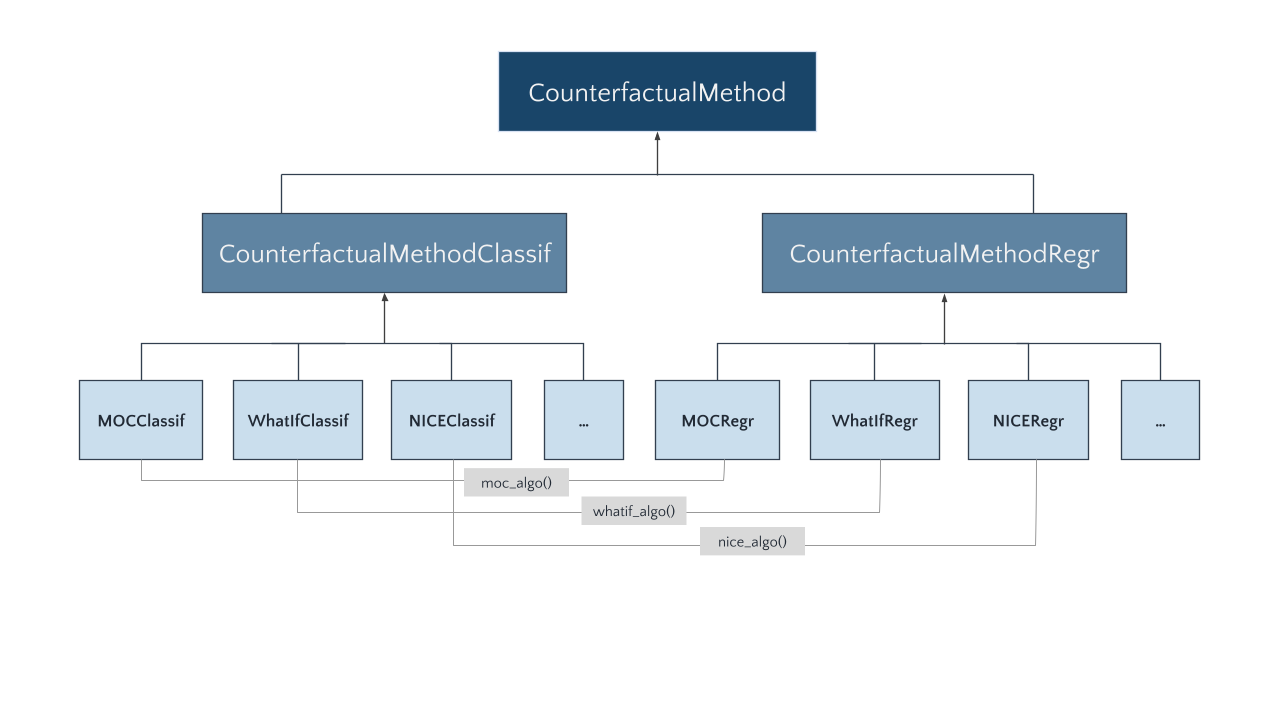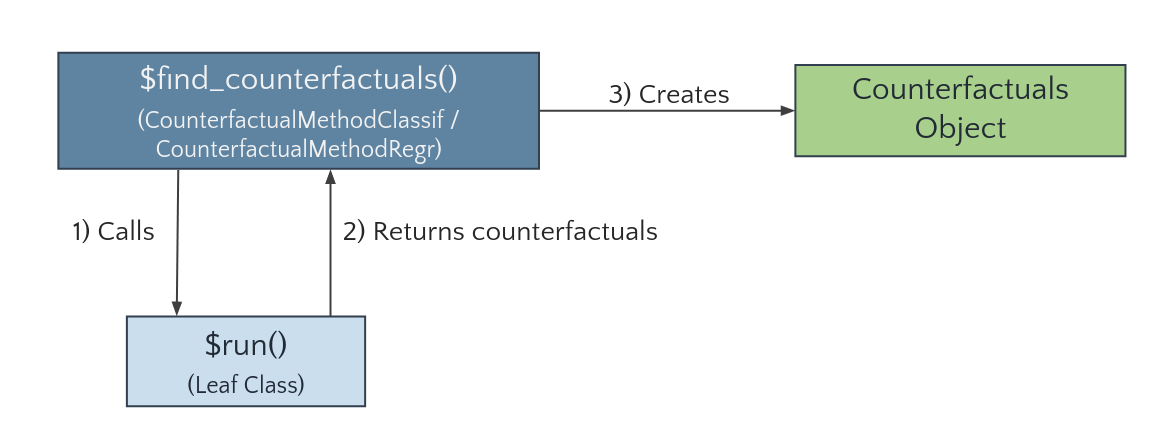How to extend the package
Source:vignettes/how-to-add-new-cf-methods.Rmd
how-to-add-new-cf-methods.RmdIn the following, we illustrate how further methods can be added to
the counterfactuals package by integrating the featureTweakR
package, which implements Feature Tweaking of Tolomei et al. (2017).
(Note that the featureTweakR package has a couple of
limitations, e.g., that factors in the training data cause problems or
that the algorithm is only applicable to randomForests
trained on standardized features. Therefore, featureTweakR
is not part of the counterfactuals package, but serves as a
suitable example for our purpose here.)
Structure of the counterfactuals package
Before we dive into the implementation details, we briefly explain
the structure of the counterfactuals package.
Class diagram
Each counterfactual method is represented by its own R6
class. Depending on whether a counterfactual method supports
classification or regression tasks, it inherits from the (abstract)
CounterfactualMethodClassif or
CounterfactualMethodRegr classes, respectively.
Counterfactual methods that support both tasks are split into two
separate classes; for instance, as MOC is applicable to classification
and regression tasks, we implement two classes: MOCClassif
and MOCRegr.

Leaf classes (like MOCClassif and MOCRegr)
inherit the find_counterfactuals() method from
CounterfactualMethodClassif or
CounterfactualMethodRegr, respectively. The key advantage
of this approach is that we are able to provide a tailored
find_counterfactuals() interface to the task at hand: for
classification tasks find_counterfactuals() has two
arguments desired_class and desired_prob and
for regression tasks it has one argument
desired_outcome.
Call graph
The find_counterfactuals() method calls a private
run() method (1)—implemented by the leaf classes—which
performs the search and returns the counterfactuals as a
data.table (2). The find_counterfactuals()
method then creates a Counterfactuals object, which
contains the counterfactuals and provides several methods for their
evaluation and visualization (3).

Integrating a new counterfactuals explanation method
To integrate Feature Tweaking, we first need to install
featureTweakR and pforeach and load the
required libraries.
devtools::install_github("katokohaku/featureTweakR")
# required for FeatureTweakeR
devtools::install_github("hoxo-m/pforeach")
library(counterfactuals)
library(randomForest)
library(featureTweakR)
library(R6)Class structure
A new leaf class needs at least two methods:
initialize() and run(). The method
print_parameters() is not mandatory, but strongly
recommended as it gives objects of that class an informative
print() output.
As elaborated above, the new class inherits from either
CounterfactualMethodClassif or
CounterfactualMethodRegr, depending on which task it
supports. Because Feature Tweaking supports classification tasks, the
new FeatureTweakerClassif class inherits from the
former.
Implement the initialize method
The initialize() method must have a predictor argument
that takes an iml::Predictor
object. In addition, it may have further arguments that are specific to
the counterfactual method such as ktree,
epsiron, and resample in this case. For
argument checks, we recommend the checkmate
package. We also fill the print_parameters() method with
the parameters of Feature Tweaking.
FeatureTweakerClassif = R6Class("FeatureTweakerClassif", inherit = CounterfactualMethodClassif,
public = list(
initialize = function(predictor, ktree = NULL, epsiron = 0.1,
resample = FALSE) {
# adds predictor to private$predictor field
super$initialize(predictor)
private$ktree = ktree
private$epsiron = epsiron
private$resample = resample
}
),
private = list(
ktree = NULL,
epsiron = NULL,
resample = NULL,
run = function() {},
print_parameters = function() {
cat(" - epsiron: ", private$epsiron, "\n")
cat(" - ktree: ", private$ktree, "\n")
cat(" - resample: ", private$resample)
}
)
)Implement the run method
The run() method performs the search for
counterfactuals. Its structure is completely free, which makes it
flexible to add new counterfactual methods to the
counterfactuals package.
The workflow of finding counterfactuals with the
featureTweakR package is explained here and
essentially consists of these steps:
# Rule extraction
rules = getRules(rf, ktree = 5L)
# Get e-satisfactory instance
es = set.eSatisfactory(rules, epsiron = 0.3)
# Compute counterfactuals
tweaked = tweak(
es, rf, x_interest, label.from = ..., label.to = ..., .dopar = FALSE
)
tweaked$suggestAs long as ktree—the number of trees to parse—is smaller
than the total number of trees in the randomForest, the
rule extraction is a random process. Hence, these steps can be repeated
resample times to obtain multiple counterfactuals.
FeatureTweakerClassif = R6Class("FeatureTweakerClassif",
inherit = CounterfactualMethodClassif,
public = list(
initialize = function(predictor, ktree = NULL, epsiron = 0.1,
resample = FALSE) {
# adds predictor to private$predictor field
super$initialize(predictor)
private$ktree = ktree
private$epsiron = epsiron
private$resample = resample
}
),
private = list(
ktree = NULL,
epsiron = NULL,
resample = NULL,
run = function() {
# Extract info from private fields
predictor = private$predictor
y_hat_interest = predictor$predict(private$x_interest)
class_x_interest = names(y_hat_interest)[which.max(y_hat_interest)]
rf = predictor$model
# Search counterfactuals by calling functions in featureTweakR
rules = getRules(rf, ktree = private$ktree, resample = private$resample)
es = set.eSatisfactory(rules, epsiron = private$epsiron)
tweaks = featureTweakR::tweak(
es, rf, private$x_interest, label.from = class_x_interest,
label.to = private$desired_class, .dopar = FALSE
)
res <- tweaks$suggest
},
print_parameters = function() {
cat(" - epsiron: ", private$epsiron, "\n")
cat(" - ktree: ", private$ktree, "\n")
cat(" - resample: ", private$resample)
}
)
)Use Case
Now, that we have implemented FeatureTweakerClassif,
let’s look at a short application to the iris dataset.
First, we train a randomForest model on the
iris data set and set up the iml::Predictor
object, omitting x_interest from the training data.
set.seed(78546)
X = subset(iris, select = -Species)[- 130L,]
y = iris$Species[-130L]
rf = randomForest(X, y, ntree = 20L)
predictor = iml::Predictor$new(rf, data = iris[-130L, ], y = "Species", type = "prob")For x_interest, the model predicts a probability of 25%
for versicolor.
x_interest = iris[130L, ]
predictor$predict(x_interest)
#> setosa versicolor virginica
#> 1 0 0.45 0.55Now, we use Feature Tweaking to address the question: “What would
need to change in x_interest for the model to predict a
probability of at least 60% forversicolor.
# Set up FeatureTweakerClassif
ft_classif = FeatureTweakerClassif$new(predictor, ktree = 10L, resample = TRUE)
# Find counterfactuals and create Counterfactuals Object
cfactuals = ft_classif$find_counterfactuals(
x_interest = x_interest, desired_class = "versicolor", desired_prob = c(0.6, 1)
)Just as for the existing methods, the result is a
Counterfactuals object.
Comments
A minor limitation of this basic implementation is that we would not
be able to find counterfactuals for a setting with
max(desired_prob) < 0.5, since
featureTweakR::tweak only searches for instances that would
be predicted as desired_class by majority vote. To enable
this setting, we would need to change some featureTweakR
internal code, but for the sake of clarity we will not do this here.
References
Tolomei, G., Silvestri, F., Haines, A., Lalmas, M.: Interpretable Predictions of Tree-based Ensembles via Actionable Feature Tweaking. In: Proceedings of the 23rd ACM SIGKDD International Conference on Knowledge Discovery and Data Mining. pp. 465–474. KDD ’17, ACM, New York, NY, USA (2017). .